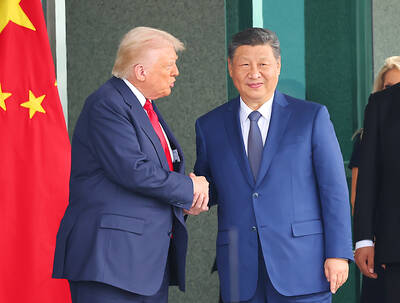The nation’s industrial production increased 3.51 percent year-on-year last month, the third consecutive month of annual growth despite the effects of the COVID-19 pandemic, Ministry of Economic Affairs data showed yesterday.
Output from the manufacturing sector, which makes up more than 90 percent of industrial output, expanded by 4.15 percent, largely due to demand for electronic components, the data showed.
“Demand for electronic components remains robust due to new technologies and services, such as 5G, the Internet of Things, cloud computing and high-performance computing,” Department of Statistics Deputy Director-General Wang Shu-chuan (王淑娟) told a news conference in Taipei.
Demand for servers, laptops, and network and communications devices has continued to surge as people increasingly work and study from home during lockdowns worldwide, Wang said, adding that the production of LCD panels and related parts also increased, ending 17 consecutive months of annual declines.
After production of integrated circuits and LCD panels grew 32.27 percent and 3.49 percent respectively, total output of the electronic components industry increased 22.15 percent year-on-year, the data showed.
Meanwhile, production in the computer, electronics and optical components industry — which increased early last year due to firms relocating back to Taiwan and transferred orders due to the US-China trade dispute — increased by 1.75 percent year-on-year.
Attributing the small increase to a high comparison base, Wang said a decline in the production of camera lenses for mobile devices dimmed the sector’s performance.
“[Although] local firms increased output thanks to growing orders on the back of demand for electronics … the pandemic has dampened demand for smartphones,” she said.
Industrial production across non-tech industries also continued to plummet, the data showed.
The output of the base metals and machinery equipment sectors fell 6.08 percent and 14.1 percent respectively due to bearish market sentiment fostered by the spread of the coronavirus.
The output of the petroleum and coal products sector plunged 16.74 percent year-on-year as international crude oil prices declined to historic lows.
The decline in the output of non-tech industries was compounded by the pandemic’s heavy toll on the airline sector, Wang said.
The automobile and auto parts sector posted its largest year-on-year decline since the global financial crisis in 2009, 21.1 percent, which Wang blamed on customers postponing purchases of new vehicles due to the lockdowns, as well as supply chain disruptions in the mechanical parts industry.
The textile industry also posted its biggest setback since 2009, a 33.09 percent year-on-year fall in production output, the data showed.

Nissan Motor Co has agreed to sell its global headquarters in Yokohama for ¥97 billion (US$630 million) to a group sponsored by Taiwanese autoparts maker Minth Group (敏實集團), as the struggling automaker seeks to shore up its financial position. The acquisition is led by a special purchase company managed by KJR Management Ltd, a Japanese real-estate unit of private equity giant KKR & Co, people familiar with the matter said. KJR said it would act as asset manager together with Mizuho Real Estate Management Co. Nissan is undergoing a broad cost-cutting campaign by eliminating jobs and shuttering plants as it grapples

TEMPORARY TRUCE: China has made concessions to ease rare earth trade controls, among others, while Washington holds fire on a 100% tariff on all Chinese goods China is effectively suspending implementation of additional export controls on rare earth metals and terminating investigations targeting US companies in the semiconductor supply chain, the White House announced. The White House on Saturday issued a fact sheet outlining some details of the trade pact agreed to earlier in the week by US President Donald Trump and Chinese President Xi Jinping (習近平) that aimed to ease tensions between the world’s two largest economies. Under the deal, China is to issue general licenses valid for exports of rare earths, gallium, germanium, antimony and graphite “for the benefit of US end users and their suppliers

Dutch chipmaker Nexperia BV’s China unit yesterday said that it had established sufficient inventories of finished goods and works-in-progress, and that its supply chain remained secure and stable after its parent halted wafer supplies. The Dutch company suspended supplies of wafers to its Chinese assembly plant a week ago, calling it “a direct consequence of the local management’s recent failure to comply with the agreed contractual payment terms,” Reuters reported on Friday last week. Its China unit called Nexperia’s suspension “unilateral” and “extremely irresponsible,” adding that the Dutch parent’s claim about contractual payment was “misleading and highly deceptive,” according to a statement

The Chinese government has issued guidance requiring new data center projects that have received any state funds to only use domestically made artificial intelligence (AI) chips, two sources familiar with the matter told Reuters. In recent weeks, Chinese regulatory authorities have ordered such data centers that are less than 30 percent complete to remove all installed foreign chips, or cancel plans to purchase them, while projects in a more advanced stage would be decided on a case-by-case basis, the sources said. The move could represent one of China’s most aggressive steps yet to eliminate foreign technology from its critical infrastructure amid a